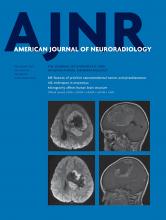Research ArticleNeurointervention
Open Access
Hemodynamic Analysis of Postoperative Rupture of Unruptured Intracranial Aneurysms after Placement of Flow-Diverting Stents: A Matched Case-Control Study
W. Li, Z. Tian, W. Zhu, Y.S. Zhang, K. Wang, Y. Zhang, Y. Wang, X. Yang and J. Liu
American Journal of Neuroradiology November 2019, 40 (11) 1916-1923; DOI: https://doi.org/10.3174/ajnr.A6256
W. Li
aFrom the Department of Interventional Neuroradiology (W.L., Z.T., W.Z., Y.S.Z., K.W., Y.Z., X.Y., J.L.), Beijing Neurosurgical Institute and Beijing Tiantan Hospital, Capital Medical University, Beijing, China
Z. Tian
aFrom the Department of Interventional Neuroradiology (W.L., Z.T., W.Z., Y.S.Z., K.W., Y.Z., X.Y., J.L.), Beijing Neurosurgical Institute and Beijing Tiantan Hospital, Capital Medical University, Beijing, China
W. Zhu
aFrom the Department of Interventional Neuroradiology (W.L., Z.T., W.Z., Y.S.Z., K.W., Y.Z., X.Y., J.L.), Beijing Neurosurgical Institute and Beijing Tiantan Hospital, Capital Medical University, Beijing, China
Y.S. Zhang
aFrom the Department of Interventional Neuroradiology (W.L., Z.T., W.Z., Y.S.Z., K.W., Y.Z., X.Y., J.L.), Beijing Neurosurgical Institute and Beijing Tiantan Hospital, Capital Medical University, Beijing, China
K. Wang
aFrom the Department of Interventional Neuroradiology (W.L., Z.T., W.Z., Y.S.Z., K.W., Y.Z., X.Y., J.L.), Beijing Neurosurgical Institute and Beijing Tiantan Hospital, Capital Medical University, Beijing, China
Y. Zhang
aFrom the Department of Interventional Neuroradiology (W.L., Z.T., W.Z., Y.S.Z., K.W., Y.Z., X.Y., J.L.), Beijing Neurosurgical Institute and Beijing Tiantan Hospital, Capital Medical University, Beijing, China
Y. Wang
bDepartment of Neurosurgery (Y.W.), The First Affiliated Hospital of Nanchang University, Nanchang University, Nanchang, China
X. Yang
aFrom the Department of Interventional Neuroradiology (W.L., Z.T., W.Z., Y.S.Z., K.W., Y.Z., X.Y., J.L.), Beijing Neurosurgical Institute and Beijing Tiantan Hospital, Capital Medical University, Beijing, China
J. Liu
aFrom the Department of Interventional Neuroradiology (W.L., Z.T., W.Z., Y.S.Z., K.W., Y.Z., X.Y., J.L.), Beijing Neurosurgical Institute and Beijing Tiantan Hospital, Capital Medical University, Beijing, China

References
- 1.↵
- 2.↵
- 3.↵
- Becske T,
- Kallmes DF,
- Saatci I, et al
- 4.↵
- Becske T,
- Brinjikji W,
- Potts MB, et al
- 5.↵
- Cebral JR,
- Mut F,
- Raschi M, et al
- 6.↵
- Siddiqui AH,
- Kan P,
- Abla AA, et al
- 7.↵
- Chow M,
- McDougall C,
- O'Kelly C, et al
- 8.↵
- Kulcsar Z,
- Houdart E,
- Bonafe A, et al
- 9.↵
- Brinjikji W,
- Murad MH,
- Lanzino G, et al
- 10.↵
- Turowski B,
- Macht S,
- Kulcsar Z, et al
- 11.↵
- Hampton T,
- Walsh D,
- Tolias C, et al
- 12.↵
- Tateshima S,
- Jones JG,
- Mayor BF, et al
- 13.↵
- 14.↵
- 15.↵
- Mitsos AP,
- Kakalis NM,
- Ventikos YP, et al
- 16.↵
- Cebral JR,
- Mut F,
- Weir J, et al
- 17.↵
- Liu J,
- Fan J,
- Xiang J, et al
- 18.↵
- He X,
- Ku DN
- 19.↵
- Zhang Y,
- Jing L,
- Liu J, et al
- 20.↵
- Takao H,
- Murayama Y,
- Otsuka S, et al
- 21.↵
- Huang Q,
- Xu J,
- Cheng J, et al
- 22.↵
- Ikeda H,
- Ishii A,
- Kikuchi T, et al
- 23.↵
- Fox B,
- Humphries WE,
- Doss VT, et al
- 24.↵
- Hassan T,
- Ahmed YM,
- Hassan AA
- 25.↵
- Frosen J,
- Piippo A,
- Paetau A, et al
- 26.↵
- 27.↵
- Schneiders JJ,
- VanBavel E,
- Majoie CB, et al
- 28.↵
- Qian Y,
- Takao H,
- Umezu M, et al
- 29.↵
- Liu J,
- Xiang J,
- Zhang Y, et al
In this issue
American Journal of Neuroradiology
Vol. 40, Issue 11
1 Nov 2019
Advertisement
W. Li, Z. Tian, W. Zhu, Y.S. Zhang, K. Wang, Y. Zhang, Y. Wang, X. Yang, J. Liu
Hemodynamic Analysis of Postoperative Rupture of Unruptured Intracranial Aneurysms after Placement of Flow-Diverting Stents: A Matched Case-Control Study
American Journal of Neuroradiology Nov 2019, 40 (11) 1916-1923; DOI: 10.3174/ajnr.A6256
0 Responses
Hemodynamic Analysis of Postoperative Rupture of Unruptured Intracranial Aneurysms after Placement of Flow-Diverting Stents: A Matched Case-Control Study
W. Li, Z. Tian, W. Zhu, Y.S. Zhang, K. Wang, Y. Zhang, Y. Wang, X. Yang, J. Liu
American Journal of Neuroradiology Nov 2019, 40 (11) 1916-1923; DOI: 10.3174/ajnr.A6256
Jump to section
Related Articles
Cited By...
This article has not yet been cited by articles in journals that are participating in Crossref Cited-by Linking.
More in this TOC Section
Similar Articles
Advertisement











